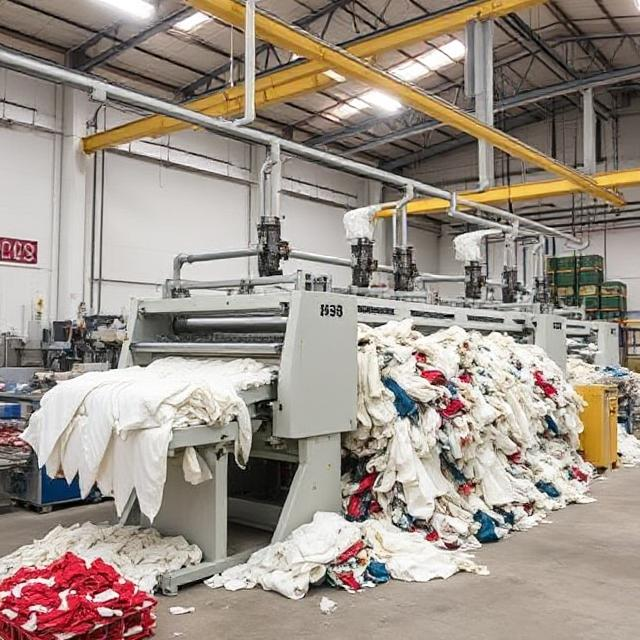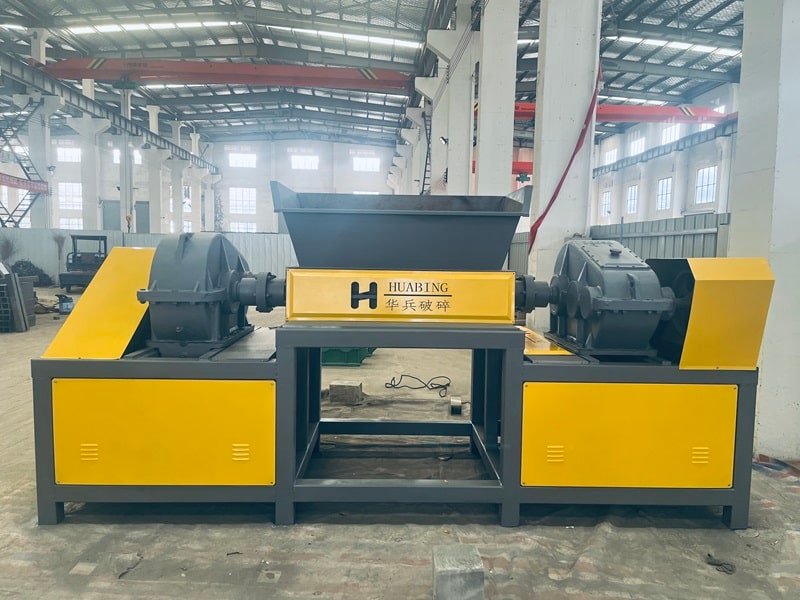Table of Contents
- Introduction
- Understanding Textile Recycling
- 2.1 What is Textile Recycling?
- 2.2 Why Is Textile Recycling Important?
- Key Machines Used in Textile Recycling
- 3.1 Shredders
- 3.2 Carding Machines
- 3.3 Spinning Machines
- 3.4 Dyeing and Finishing Equipment
- 3.5 Sorting Machines
- 3.6 Textile Granulators
- 3.7 Compactors and Presses
- Focus on the Hbshredder 37kW Trash Large Double Shaft Shredder
- 4.1 Specifications and Features
- 4.2 How It Contributes to Textile Recycling
- Challenges in Textile Recycling
- The Future of Textile Recycling Machines
- Frequently Asked Questions
- Conclusion
Introduction
Textile recycling is an essential process that helps reduce waste, conserve resources, and lower environmental impact. It involves reclaiming used textiles and converting them into raw materials that can be reused in the production of new textiles or other products. Textile recycling plays a pivotal role in addressing the growing issue of textile waste, which contributes significantly to landfills and environmental degradation.
In this article, we will explore the different machines used in textile recycling and the technology behind these processes. We will also delve into one particular machine—the Hbshredder 37kW Trash Large Double Shaft Shredder—to understand its specifications, features, and contribution to the textile recycling industry.

Understanding Textile Recycling
2.1 What is Textile Recycling?
Textile recycling refers to the process of collecting and processing discarded or worn-out clothing, fabrics, and other textile products to create new materials. This process reduces the need for virgin raw materials, cuts down on the environmental footprint, and saves energy.
The textile recycling process typically involves several stages, including:
- Collection and sorting of waste textiles.
- Shredding of the materials to break them down into smaller pieces.
- Cleaning and sorting to remove any contaminants.
- Processing to create fibers or fabrics that can be used in new textile production or other industries.
2.2 Why Is Textile Recycling Important?
The textile industry is one of the largest contributors to global pollution, with millions of tons of clothing being discarded each year. Recycling textiles helps mitigate these issues by:
- Reducing the amount of textile waste in landfills.
- Saving natural resources such as water, energy, and raw materials.
- Lowering the carbon footprint of textile production.
By recycling textiles, we not only reduce waste but also create a more sustainable production cycle for fabrics and garments.
Key Machines Used in Textile Recycling
Textile recycling involves various machines, each designed to perform specific tasks in the process. Let’s look at some of the most common machines used in textile recycling.
3.1 Shredders
Shredders are the first step in textile recycling. They break down large textiles into smaller pieces or fibers, making them easier to process further. Shredders can handle a wide variety of materials, including cotton, polyester, wool, and mixed-fiber fabrics.
Types of Shredders:

- Single Shaft Shredders: Used for shredding textiles into smaller pieces, ideal for easy handling and further processing.
- Double Shaft Shredders: More powerful and capable of handling tougher fabrics and larger volumes of textile waste. The Hbshredder 37kW Trash Large Double Shaft Shredder is a prime example of this type of machine.
3.2 Carding Machines
After shredding, the fibers need to be aligned and cleaned to prepare them for further processing. Carding machines help untangle and straighten the fibers to make them suitable for spinning into yarn. These machines are crucial for converting waste textiles into a usable form for new fabric production.
3.3 Spinning Machines
Spinning machines take the processed fibers from the carding stage and spin them into yarn. The yarn can then be woven or knitted into new fabric. Spinning machines are essential in transforming recycled fibers into high-quality threads used in textile production.
3.4 Dyeing and Finishing Equipment
Once the yarn or fabric is created, dyeing and finishing machines are used to add color and texture to the material. Textile recycling involves cleaning and dyeing the recycled fibers, which may require specific machines to ensure high-quality finishes.
3.5 Sorting Machines
Sorting machines are used to classify textiles based on material type, color, and quality. This step ensures that the textiles are sorted properly before they enter the recycling process. Sorting is a vital part of textile recycling, as different materials require different processing methods.
3.6 Textile Granulators
Granulators are used to reduce textile waste into small granules or pellets. These granules can be further processed to create new products, such as insulation material or nonwoven fabrics. Granulators are particularly useful in recycling synthetic fabrics like polyester and nylon.
3.7 Compactors and Presses
After textiles are shredded and processed, they are often compacted to reduce volume and facilitate easier transportation. Compactors and presses help condense the shredded material into compact bales for efficient storage and shipping.
Focus on the Hbshredder 37kW Trash Large Double Shaft Shredder
One of the key machines in the textile recycling process is the Hbshredder 37kW Trash Large Double Shaft Shredder. Let’s explore its features and how it contributes to efficient textile recycling.
4.1 Specifications and Features

The Hbshredder 37kW Trash Large Double Shaft Shredder is a robust and efficient machine designed for heavy-duty textile waste processing. Here are its key specifications:
- Shaft Diameter: 120mm
- Shaft Length: 2000mm
- Power: 2 x 110kW dual motors for maximum performance
- Feed Size: ≤1200mm (adjustable inlet)
- Output Size: 20-200mm (adjustable knives and screen)
- Throughput: 5-20 tons per hour (depending on material type and density)
- Dimensions: 4.5 × 2.5 × 2.8 meters
- Weight: 22 tons
- Material of Construction: Heavy-duty steel with wear-resistant linings
4.2 How It Contributes to Textile Recycling
The Hbshredder 37kW Trash Large Double Shaft Shredder is ideal for handling large volumes of textile waste. It can shred a variety of textile materials, from fabrics to mixed fibers, into small pieces for further processing. With its high power and adjustable settings, this shredder is suitable for both small-scale and industrial-scale textile recycling operations.
The machine’s powerful dual motors ensure fast and efficient shredding, while the adjustable output size and feed size allow operators to customize the machine for different materials. Its heavy-duty construction and wear-resistant linings make it durable enough to handle tough textile waste, reducing downtime and improving productivity.
Challenges in Textile Recycling
While textile recycling holds great potential, there are several challenges that come with it. Some of the key challenges include:
- Contamination: Textiles are often mixed with other materials like buttons, zippers, and plastics, making the recycling process more complicated.
- Fiber Quality: Recycled fibers may have lower quality than virgin fibers, making it difficult to create high-end fabrics.
- Sorting Issues: Efficiently sorting textiles based on material type and quality is a labor-intensive task that requires advanced technology.
- Cost of Recycling: The cost of setting up and maintaining recycling facilities can be high, especially for small-scale operations.
The Future of Textile Recycling Machines
The future of textile recycling looks promising, with innovations in machine technology aimed at improving efficiency and sustainability. Some key trends in textile recycling machines include:
- Automation: More automated systems are being introduced to streamline the sorting, shredding, and processing of textiles.
- Advanced Sorting Technology: Improved sorting machines, including optical scanners, will help separate textiles more efficiently based on material type and color.
- Sustainability: Manufacturers are developing eco-friendly recycling machines that use less energy and produce fewer emissions.
Frequently Asked Questions
1. What is the role of a shredder in textile recycling?
Shredders break down large textile waste into smaller pieces, making it easier to process further and create new materials from recycled fabrics.
2. What types of textiles can be recycled using shredders?
Shredders can handle a wide variety of textiles, including cotton, polyester, wool, mixed-fiber fabrics, and synthetic materials.
3. How do I know which machine is suitable for my textile recycling needs?
Consider the volume of material you need to process, the type of textiles involved, and your specific recycling goals when choosing a machine. Consulting with an expert in textile recycling can help you select the most appropriate equipment.
Conclusion
Textile recycling is a vital process that reduces waste and promotes sustainability. Various machines, such as shredders, carding machines, and spinning machines, play key roles in recycling textiles into usable materials. The Hbshredder 37kW Trash Large Double Shaft Shredder is one of the most powerful and efficient machines used in textile recycling, contributing to the industry’s efficiency.
As the textile recycling industry continues to evolve, advancements in machine technology will help address the challenges faced by recyclers. By investing in high-quality recycling equipment, businesses can contribute to a more sustainable future for the textile industry.
